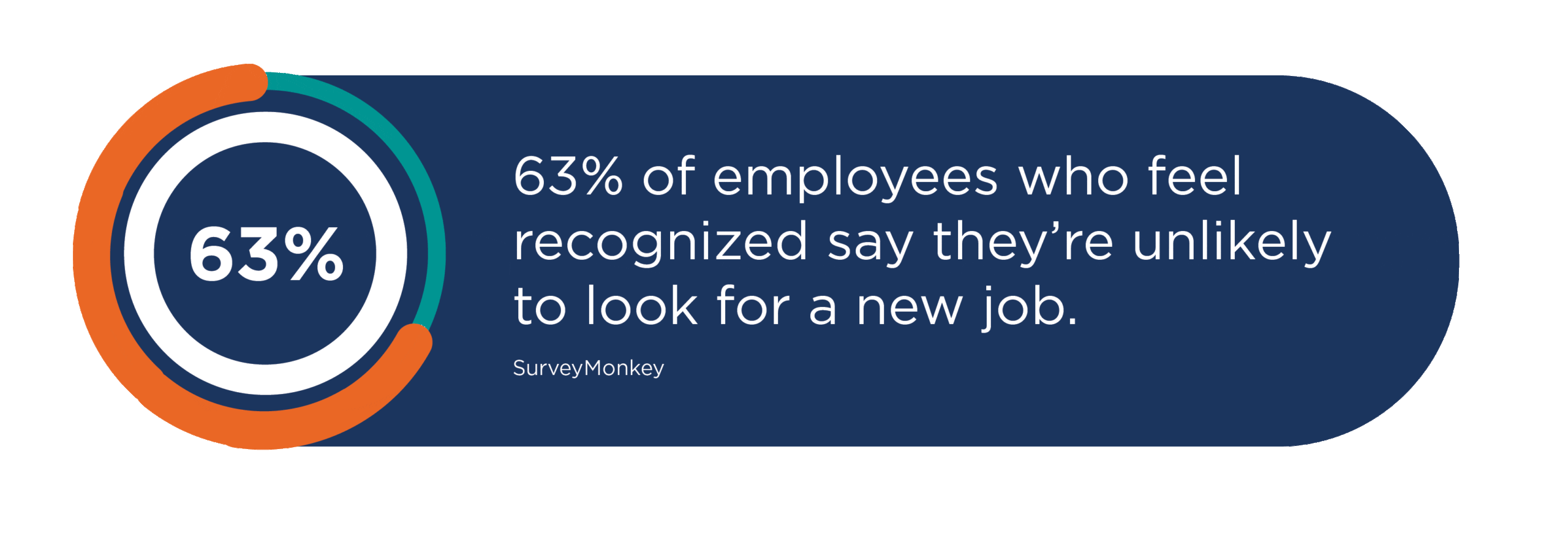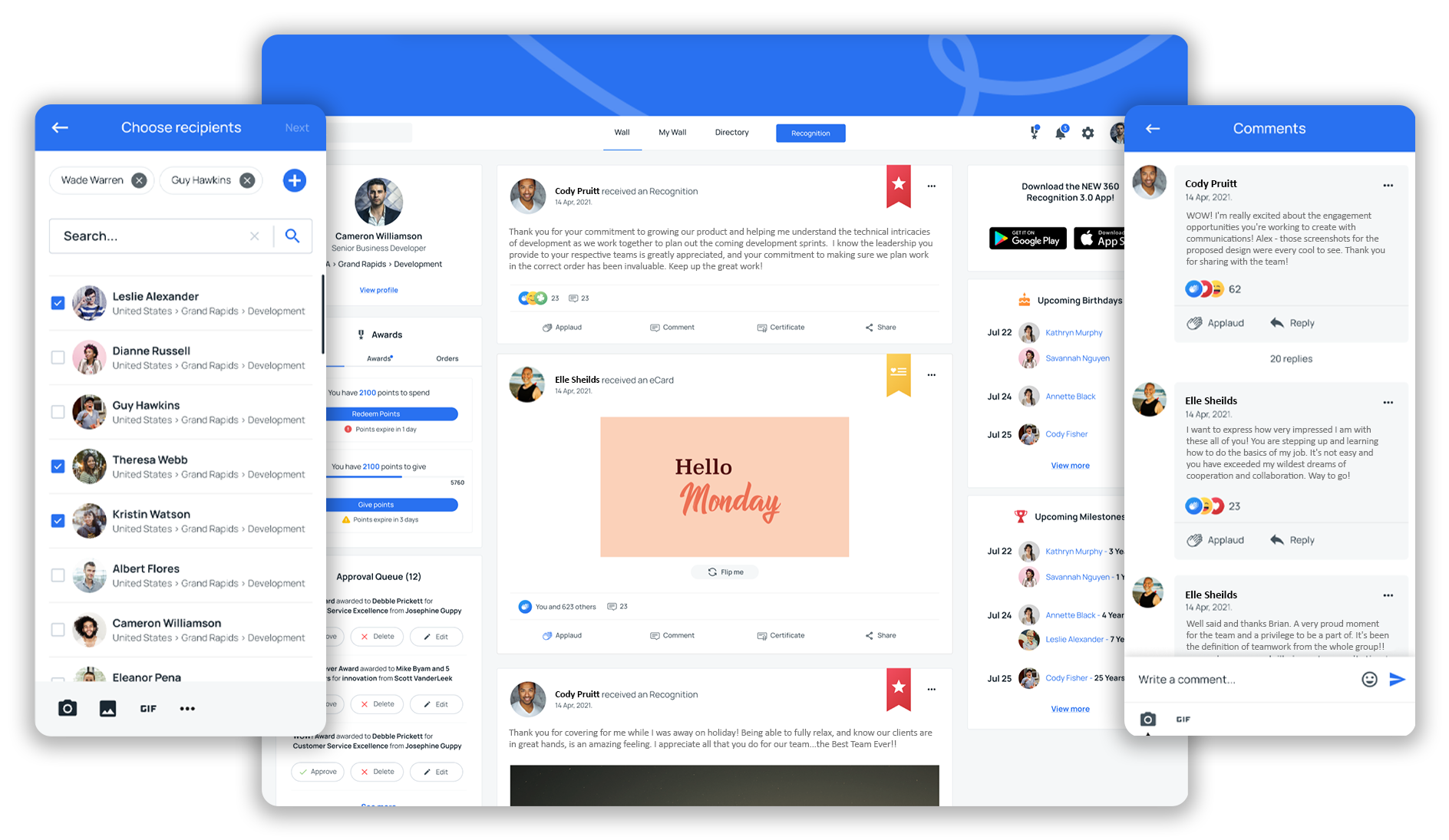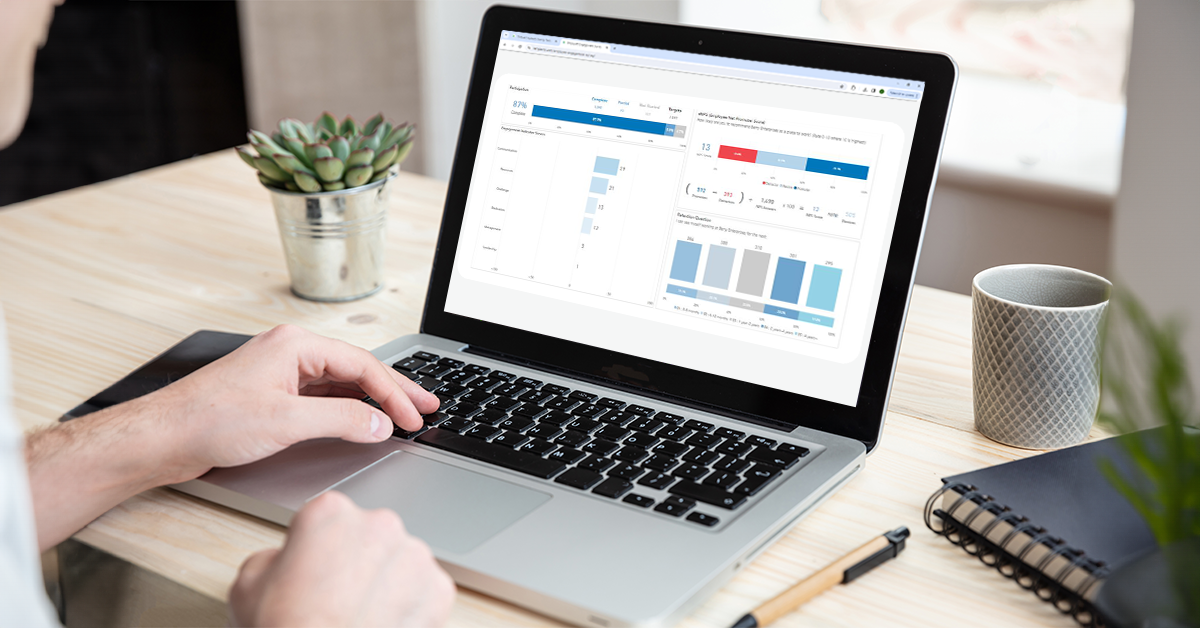February 11, 2025

Watch any team sport and you’ll notice that players aren’t only getting positive feedback from their coach. They’re also getting support from each other. A pat on the back. A “great shot!” A high five.
Your company may not be a sports team, but the sentiment is the same. And employee recognition programs, especially those that facilitate peer-to-peer recognition among employees, can offer that same level of support. These programs often include tools and platforms that allow for customization, tracking results, and fostering an inclusive work environment through strategic recognition initiatives.
Here, we’ll discuss what a peer-to-peer recognition program is, peer-to-peer recognition benefits, and 7 best practices for peer-to-peer recognition.
What is Peer Recognition?
Peer recognition refers to the acknowledgment, appreciation, and validation of an individual's contributions, achievements, skills, or qualities by their peers. Peers are typically individuals who share similar roles, responsibilities, or work within the same team, department, or organization.
Peer-to-peer recognition is sometimes also known as social recognition and can be a great way to live your company values every day.
Definition and Importance
Peer-to-peer recognition is a powerful tool for fostering a positive and productive work environment. Unlike traditional recognition that comes from managers or executives, peer recognition involves employees acknowledging and appreciating the efforts and achievements of their colleagues. This approach not only democratizes the recognition process but also ensures that everyday contributions are noticed and valued.
The importance of peer-to-peer recognition cannot be overstated. It has a significant impact on employee engagement, motivation, and job satisfaction. When employees feel valued by their peers, they are more likely to be engaged in their work, exhibit higher levels of motivation, and experience greater job satisfaction. This, in turn, leads to a more cohesive and collaborative team environment, where everyone feels appreciated and driven to contribute their best.
Peer recognition can take various forms, including:
Verbal Acknowledgment:
Encourage employees to verbally recognize and praise each other for their efforts, accomplishments, or positive attributes during team meetings, discussions, or informal interactions, fostering a workplace culture that values recognition and appreciation.
Written Recognition:
This can include emails, messages, or notes sent by peers to express appreciation, congratulate, or thank each other for their contributions.
Awards and Certificates:
Some organizations have formal programs where peers can nominate each other for awards or certificates to recognize outstanding performance, innovation, teamwork, leadership, or other noteworthy qualities.
Peer Feedback:
Constructive feedback from peers can also be a form of employee recognition, as it acknowledges the value of an individual's work while also providing insights for improvement.
Peer-to-Peer Recognition Programs:
These are structured initiatives within organizations that encourage and facilitate peer recognition through a peer recognition model, where peers and leadership can actively participate in recognizing each other’s efforts using specific platforms, tools, or processes. They often involve nominations, voting, and rewards for recognized individuals.
Peer recognition is important in fostering a positive company culture, boosting morale, enhancing teamwork and collaboration, and increasing overall employee satisfaction. It promotes a sense of appreciation, respect, and camaraderie among colleagues, contributing to a more supportive and productive work environment.

What is a Peer-to-Peer Recognition Program?
A peer-to-peer recognition program is a structured initiative within an organization designed to encourage and facilitate the acknowledgment, appreciation, and validation of employees' contributions. These programs are often implemented to promote a positive work culture, boost morale, enhance collaboration, and increase overall job satisfaction.
Peer recognition programs offer a solution that allows you to build camaraderie between employees no matter where they’re located. This helps create a recognition-rich culture that boosts employee retention, morale, and performance.
Key features of peer-to-peer recognition programs may include:
- Nominations: Employees are encouraged to nominate their peers for recognition based on specific criteria such as exceptional performance, teamwork, innovation, leadership, customer service, or other noteworthy contributions.
- Individual and Team Recognitions: It's important to recognize both individual contributions and team efforts. By promoting a recognition culture that includes both individual and team recognitions, organizations can foster inclusivity and ensure that all contributions are appreciated.
- Recognition Platforms: Many organizations use dedicated recognition platforms or software tools, Like Terryberry's Be Recognized, where employees can submit nominations, vote, track recognition activities, and view a leaderboard or recognition wall showcasing recognized individuals.
- Reward Systems: Peer recognition programs often include reward systems such as certificates, custom awards, redeemable points, or other incentives to acknowledge outstanding performance or behaviors.
- Regular Communication: Effective communication is essential for the success of peer-to-peer recognition programs. Organizations can promote their program through internal communications, newsletters, team meetings, or training sessions to ensure employees understand the program’s purpose, criteria, and how to participate.
- Analytics: Some programs incorporate analytics to gather insights on the effectiveness of the recognition program, gather suggestions for improvement, and ensure ongoing engagement and participation from employees.
With these programs, employees are provided the training and resources necessary to celebrate their coworkers. This substantially increases the amount of recognition that employees give and receive.
An effective peer recognition program can be a great way to strengthen community and collaboration as well, leading to a greater sense of belonging in the workplace.
Terryberry’s social recognition platform is accessible through a website or mobile app and fosters a positive and engaging environment with features similar to popular social media platforms, including GIFs and reactions, encouraging ongoing interaction and recognition.

Establishing an Effective Peer Recognition Program
Establishing an effective peer recognition program requires careful planning and consideration. Here are some key steps to follow to ensure your program is successful and well-received by your employees.
Define Your Objectives
Before implementing a peer recognition program, it’s essential to define your objectives. What do you hope to achieve through the program? Is it to increase employee engagement, improve morale, or boost productivity? Having clear objectives will help guide the development and implementation of the program.
For instance, if your goal is to enhance employee engagement, you might focus on creating opportunities for frequent and meaningful recognitions. Clear objectives will also help you measure the program’s success and make necessary adjustments over time.
Build a Team to Implement the Program
Building a team to implement the program is can be a great way to ensure its success. This team should include representatives from various departments and levels of the organization. By having a diverse team, you ensure that different perspectives and needs are considered.
The team will be responsible for developing the program’s framework, communicating its benefits to employees, and ensuring its smooth operation. They will also play a key role in monitoring the program’s progress and making any necessary adjustments to keep it aligned with the company’s goals.
Collect Input from Your Employees
Collecting input from employees is vital to creating a peer recognition program that meets their needs and expectations. This can be done through pulse surveys, focus groups, or one-on-one interviews. By involving employees in the development process, you can ensure that the program is tailored to their preferences and will be well-received.
Employee feedback can provide valuable insights into what types of recognition are most meaningful to them and how they would like the recognition process to be structured. This collaborative approach not only helps in designing a more effective program but also fosters a sense of ownership and buy-in from the employees.
By following these steps, you can establish a peer recognition program that not only aligns with your company’s objectives but also resonates with your employees, leading to a more engaged and motivated workforce.
What are the Benefits of Peer-to-Peer Recognition?
Peer recognition programs play a crucial role in creating a workplace environment where employees feel valued, appreciated, and motivated to contribute their best efforts. But recognition software can lead to more positive outcomes:
Empower Employees
Being noticed by executives is important, but oftentimes it’s the day-to-day duties that keep a business running smoothly. Even the world’s best boss will inevitably miss some moments of employee success worthy of acknowledgment.
But that’s where having a culture of peer recognition can help. With a peer recognition program, employees are trained how to use the program and when. It gives employees control, with no need for supervision.
This allows managers to trust their employees to step in and recognize each other, while giving employees a sense of ownership.
This isn’t to say that managers can skip out on recognition. In fact, managers oftentimes need to lead by example to win employee buy-in.
But once a peer recognition platform has been implemented and adopted, recognition won’t fall solely on the shoulders of managers.
Improve Engagement and Morale
When companies adopt a peer-to-peer recognition culture, all employees are encouraged to engage in the back and forth of peer recognition. And when the whole team is looking for things to appreciate from each other, there’s more recognition to be found.
In fact, Psychology Today found that practicing gratitude reduces a multitude of toxic emotions, from envy and resentment to frustration and regret.
Furthermore, seeking out things to be thankful for can enhance empathy and reduce stress. So, while being recognized feels good for the person receiving the thanks, it also benefits the giver.
Research has even found that when employees believe they will be recognized, they are 2.7x more likely to be highly engaged in their work.
Additionally, a report from Gallup found that business that scored in the top quartile in employee engagement have nearly double the odds of success when compared with those in the bottom quartile. Those at the 99th percentile have four times the success rate of those at the first percentile.

Reduce Voluntary Turnover
If turnover is a concern for your company, you’re not alone. The Great Resignation left 11.5 million jobs vacant at the end of June 2021. And it's not over yet. Gallup research found that 48% of employees are actively looking to switch jobs, as well.
With voluntary turnover still a top concern among many companies in 2022, recognition is more critical than ever. Simply put, recognizing your employees can lead to more engaged employees and engaged employees are less likely to leave.
In fact, according to a SurveyMonkey survey, 63% of employees who feel recognized say they’re unlikely to look for a new job.
Additionally, research from Forbes found that companies with effective recognition programs have 31% lower voluntary turnover. So, if you’re looking to prevent voluntary turnover, a recognition program is a great place to start.
Celebrate Unsung Heroes
It’s an unfortunate reality of life that sometimes people are overlooked for their accomplishments, especially the more introverted members of the workforce.
In fact, one survey found that while the workforce is generally split evenly between extroverts and introverts, 88% of supervisors are extroverted. Furthermore, only 2% of senior executives are introverts.
A common assumption from this data is that extroverts are better suited for leadership roles based on their skill sets. However, another study led by Professor Adam Grant found that introverted leaders outperformed extroverted ones when managing proactive employees.
This isn’t to say you should switch to only promoting introverts, but more so to shed light on the unsung heroes of your organization. Some of your top performers may be undetected by top leadership but are known well amongst the team for their work.
A peer recognition program helps those under-the-radar employees get the appreciation they deserve while shedding light on where your true talent may be hiding.
RELATED: 5 Ways to Retain Employees During the Great Resignation

Why is Peer Recognition Important?
There’s no denying that it feels good when someone voices appreciation for something you’ve done. Whether it’s a task outside of your normal duties or a part of your everyday routine, it feels nice to be noticed.
In workplaces where peer recognition is standard practice, employees are empowered to recognize peers and to celebrate the accomplishments of others, both big and small.
Research has shown just how important peer recognition is in increasing employee engagement, decreasing employee turnover, and creating a healthy workplace where individuals thrive.

68% of HR representatives say that employee recognition positively impacts employee retention.
When employees know that their efforts are seen and appreciated, they’re more likely to remain in their current position.
Higher turnover rates in an organization can lead to increased job stress and decreased collaboration between those who remain. Not to mention all of the costs associated with replacing an employee.
Companies scoring in the top 20% for their culture of recognition had turnover rates 31% lower.
Replacing employees is expensive. The Society for Human Resource Management has found that replacing an employee typically costs an average of 6-9 months of their salary.
Additionally, a study from Forbes estimated that replacing an employee could cost anywhere from 50-200% of their salary, depending on their position and skills. At the bare minimum, companies can expect to spend at least half of a position’s salary in finding and training a replacement.
Only one in three employees were recognized for their work in the last 7 days, according to a 2016 Gallup poll.
Another report found that employees had averaged 50 days since they were last recognized.
It’s important for employees to receive recognition from people at all levels of an organization. Managers should offer regular praise, but the ratio of supervisors to employees ultimately limits the number of interactions that they can have.
Peer-to-peer recognition can exponentially increase the amount of appreciation that an employee receives.
40% of Americans would put more effort into their work if they were recognized.
Some estimates have found that more than 22 million Americans are actively disengaged in their work. This costs the US economy up to $300 billion every year just in loss of productivity.
Throw in illness, fraud, absences, turnover, and injuries, and disengaged employees cost the US economy up to $1 trillion a year. Recognition proactively combats feelings of disengagement and isolation.
82% of employees feel like recognition is a key component in their workplace satisfaction.
People are happier at work when they know their efforts are seen and appreciated.
Peer recognition gets to the heart of employee performance. While praise from managers and leaders is always valuable, people in these positions may sometimes have only a bird’s eye view of an employee’s performance. Co-workers, on the other hand, see the day-to-day successes of each other.
They’re likely to celebrate when a peer takes the lead on a new project or initiates a system that will save everyone time. This makes peer recognition an ideal avenue for acknowledging the actions and team members that contribute to the overall advancement of a company.

Best Practices for Your Peer-to-Peer Recognition Program
A successful peer recognition program doesn’t happen by chance, but thanks to deliberate planning and research. Here are a few best practices to get you started.
Build a culture of recognition in your organization
A strong recognition culture retains current employees and attracts new talent. This requires starting from the top down.
Company leadership needs to model the behaviors you want to see in employees by visibly celebrating others in the organization.
Investing time, money, and effort into employee recognition highlights its importance. A recognition program using just 1% of payroll has a positive impact on workplace culture as well as can boost employee morale, engagement, and happiness.
People want to feel appreciated. They want to hear that the work they contribute is meaningful. Intentionality is key to building a culture of recognition.
Dedicate time to peer recognition for your team
Making time for peer recognition can mean a few different things.
First, you’ll likely need to devote time and effort to fully implement the practice. Communicate with employees:
- your goals for peer-to-peer recognition.
- what recognition might look like.
- what resources are available for peer recognition.
This communication needs to happen at all levels of the organization. Gallup research has found that almost three-quarters of businesses don’t train employees and managers in recognition best practices. Without this training, managers are less prepared to cultivate a work culture of recognition your company is striving for.
You can also make it customary to allot 5-10 minutes of meetings to celebrate a recognition moment. By establishing this as a standard practice, you’re providing a direct avenue for this type of recognition and highlighting its priority.
Finally, consider how you can support employees in recognizing their co-workers with peer recognition programs. While the practice shouldn’t be required, it also shouldn’t be added to the plates of already overwhelmed workers.
Talk to people and find out what they need to actively participate in peer-to-peer recognition. This could include anything from an extra 10 minutes at lunch to an online peer-to-peer recognition app or platform.
Implement a peer recognition platform
Peer recognition comes in many different forms - quick comments of appreciation, thank you notes, or email shout-outs, to name a few.
There’s no one right way to recognize employees, but there are ways to streamline and simplify the process. Virtual employee recognition platforms offer an approach everyone can appreciate.
Instead of asking HR representatives to piece together a program, an all-in-one platform establishes a framework and rewards system that allows for consistent employee recognition, with everything in one place. Terryberry’s Social Recognition Platform and Program is designed for both peer recognition and manger-led recognition.
A recognition platform also makes it much easier for you to analyze the metrics related to your program. This can help inform future decisions about the program.

Be considerate of individual preferences for positive reinforcement
An employee recognition survey of over 16,000 professionals noted several key takeaways in how employees prefer to receive recognition.
The majority of employees prefer for recognition to be delivered privately or in a small group rather than widely publicized.
When survey respondents were asked how they preferred to be recognized for a significant accomplishment, 47% selected a new growth opportunity. This was chosen more often than a salary increase (23%), a high-performance rating (21%), or a bonus (10%).
Knowing the form and manner that employees prefer to receive recognition in the workplace can make the act that much more meaningful.
Employee preferences regarding the frequency of recognition also vary by age. 36% of Generation Z appreciate receiving peer recognition a few times a week, followed by 28% of Millennials, 20% of Generation X, and 18% of Baby Boomers.
Although it may be easy to scoff at the hunger for praise that younger employees have, it’s important to consider that this recognition will have long-lasting effects on their performance and tenure at your company.
RELATED: 5 Traits of Gen Z: Their Wants, Needs, and Values in the Workplace
Align guidelines with your company’s mission and values
James Clear, the author of Atomic Habits, shared, “What gets rewarded, gets repeated.”
By aligning your recognition program with the mission and values of your company, you are internally promoting what your company stands for.
But how exactly do you put this into practice? It’s all in the way you design your recognition program. When you introduce a peer recognition program, collaborate with employees to identify what mindsets and actions reflect your company’s values.
Then, create opportunities for employees to recognize those behaviors in others, whether it’s excellent customer service or unparalleled persistence on a tough project.
Follow the data
Even though companies are spending over $46 billion every year on recognition programs, 87% don’t use metrics to track the return on their investment. But with an online peer recognition program like Terryberry's Be Recognized, there are a number of metrics you can measure.
- Employee engagement: What percentage of employees are actively participating on the platform? How often do they log in and interact?
- Budget use: Is the budget you’ve allotted for employee recognition being fully used? Examining budget utilization can guide you in making adjustments as needed.
- Retention: Have you seen a decrease in employee turnover with the implementation of a peer-to-peer recognition program?
- Productivity and profitability: Has your company experienced financial gains with a peer recognition program in place? Although this data is indirectly connected, it’s worth taking a look at.
Encourage peer recognition in conjunction with top-down recognition
Be mindful of not letting peer recognition replace praise from management and executives. Encouraging employees to nominate peers as wellness champions promotes a culture that values healthy practices and work-life balance. Employees need peer-to-peer recognition and acknowledgment coming from all levels of an organization. This includes colleagues, direct supervisors, and the leadership above direct supervisors.
Are you ready to boost engagement with a successful employee recognition program? Terryberry’s employee recognition software allows you to design a custom recognition platform tailored to your needs. Contact us to get started today!
Be considerate of individual preferences for positive reinforcement
An employee recognition survey of over 16,000 professionals noted several key takeaways in how employees prefer to receive recognition. The majority of employees prefer for recognition to be delivered privately or in a small group rather than widely publicized.
When survey respondents were asked how they preferred to be recognized for a significant accomplishment, 47% selected a new growth opportunity. This was chosen more often than salary increase (23%), high performance rating (21%), or a bonus (10%).
Knowing the form and manner that employees prefer to receive recognition can make the act that much more meaningful.
Employee preferences regarding the frequency of recognition also vary by age. 36% of Generation Z appreciate receiving peer recognition a few times a week, followed by 28% of Millennials, 20% of Generation X, and 18% of Baby Boomers. Although it may be easy to scoff at the hunger for praise that younger employees have, it’s important to consider that this recognition will have long-lasting effects on their performance and tenure at your company.
RELATED: 5 Traits of Gen Z: Their Wants, Needs, and Values in the Workplace
Align guidelines with your company’s mission and values
James Clear, the author of Atomic Habits, shared, “What gets rewarded, gets repeated.”
By aligning your recognition program with the mission and values of your company, you are internally promoting what your company stands for.
But how exactly do you put this into practice? It’s all in the way you design your recognition program. When you introduce a peer recognition program, collaborate with employees to identify what mindsets and actions reflect your company’s values. Then, create opportunities for employees to recognize those behaviors in others, whether it’s excellent customer service or unparalleled persistence on a tough project.
Follow the data
Even though companies are spending over $46 billion every year on recognition programs, 87% don’t use metrics to track the return on their investment. But with an online peer recognition program, there are a number of metrics you can measure.
- Employee engagement: What percentage of employees are actively participating on the platform? How often do they log in and interact?
- Budget use: Is the budget you’ve allotted for employee recognition being fully used? Examining budget utilization can guide you in making adjustments as needed.
- Retention: Have you seen a decrease in employee turnover with the implementation of a peer to peer recognition program?
- Productivity and profitability: Has your company experienced financial gains with a peer recognition program in place? Although this data is indirectly connected, it’s worth taking a look at.
Encourage peer recognition in conjunction with top down recognition
Be mindful in not letting peer recognition replace praise from management and executives. Employees need peer-to-peer recognition and acknowledgment coming from all levels of an organization. This includes colleagues, direct supervisors, and the leadership above direct supervisors.
Are you ready to boost engagement with a successful employee recognition program? Terryberry’s employee recognition software allows you to design a custom recognition platform tailored to your needs. Contact us to get started today!


